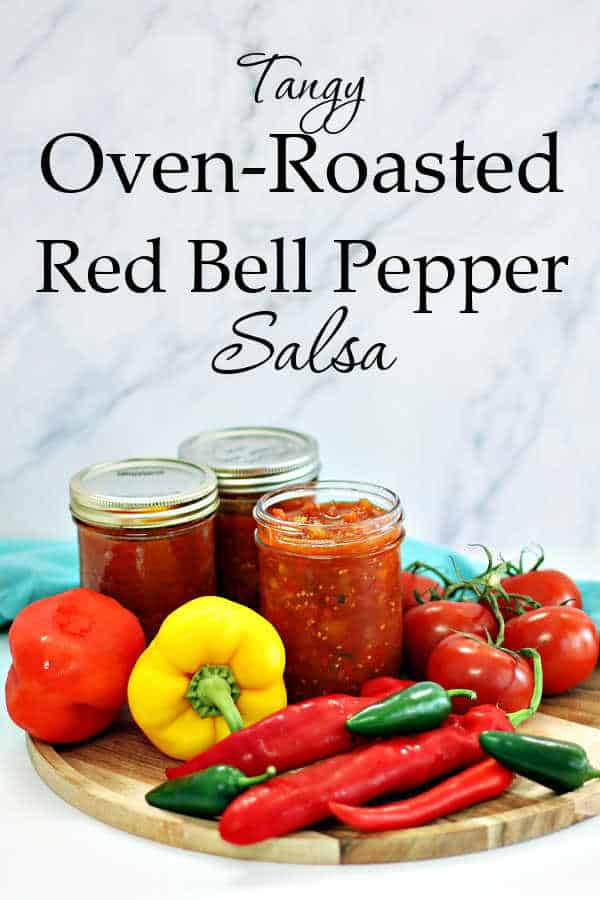The Best Strawberry Rhubarb Jam (with no pectin)
The Best Strawberry Rhubarb Jam (with no pectin). Fresh juicy strawberries and tart, tangy red rhubarb are the perfect jam combo. The taste of summer in a jar. Plan your jam day in early summer when both are at their peak of freshness.
Today’s recipe is one of my all time favorites, The Best Strawberry Rhubarb Jam (with no pectin). You are going to love how quick and easy this recipe is with only 4 ingredients and the flavor is clean and crisp.
No commercial pectin is used in this jam. Cook it until thickened using sugar and orange rind, then place in canning jars and water bath to preserve.
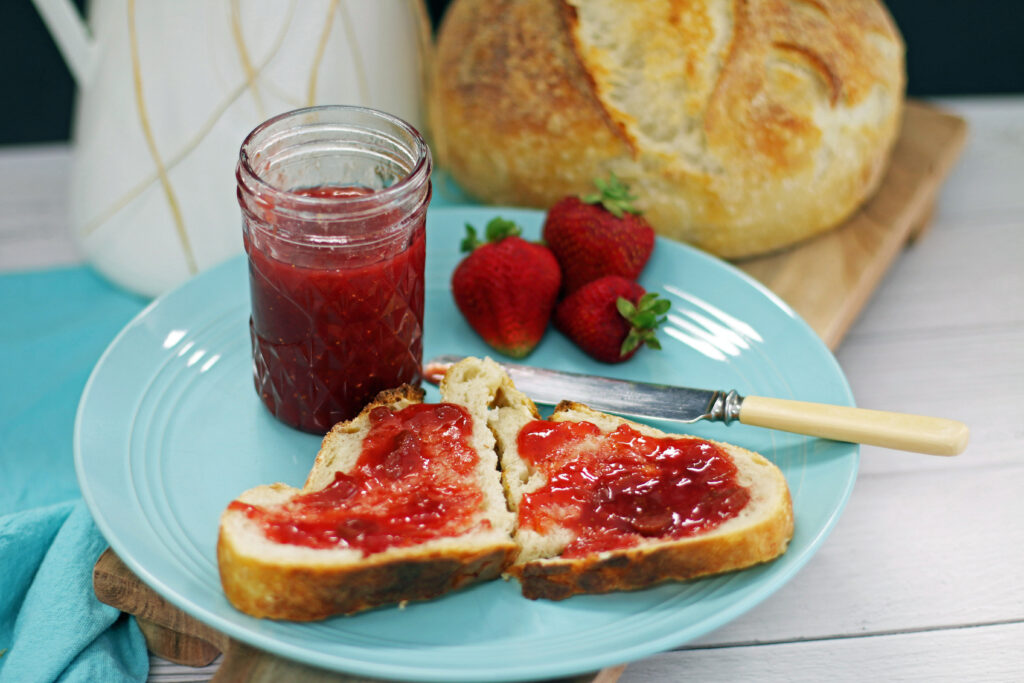
Why is this the Best Strawberry Rhubarb Jam Recipe?
- With only 4 ingredients, it’s fast and easy to create, and oh so tasty.
- It’s been in our family for generations, so it’s tested and true
- No commercial pectin. Many people use commercial pectin to thicken jam. I prefer to use natural pectin found in fruits.
- This jam is perfect on warm sourdough, add a dollop to your oatmeal, slather on your sourdough discard pancakes or ice-cream.
- You can make it as freezer jam, or water bath to seal the jars for a longer preserve (instructions at the end of this post for water bath).
- You will want to make double batches so you don’t run out.
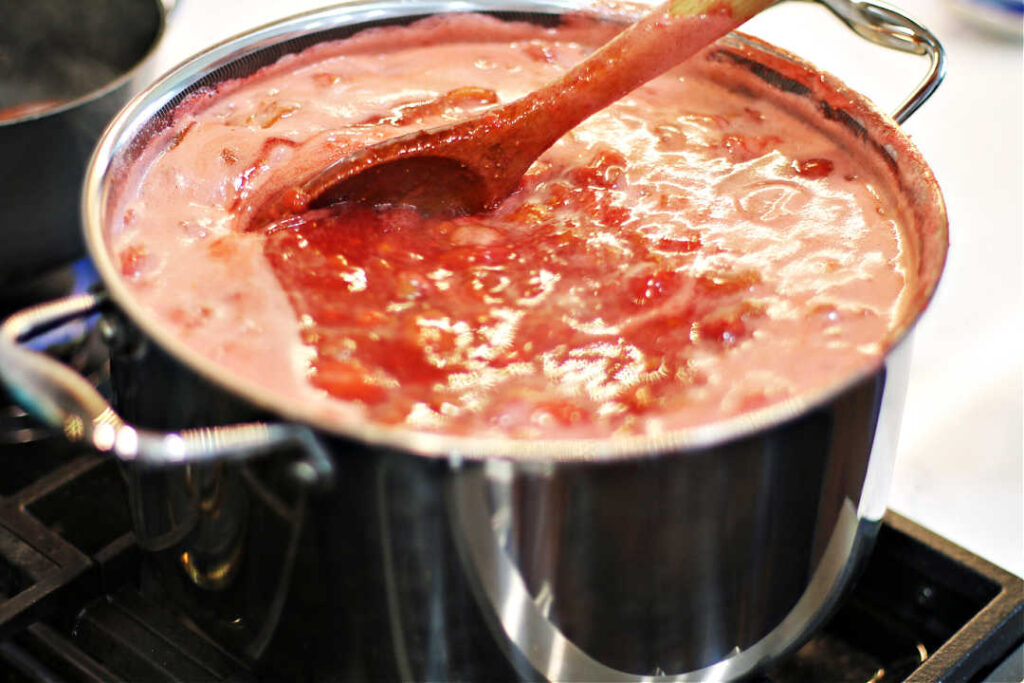
Strawberry Rhubarb Jam is a staple in our home with it’s perfect balance of sweet and tart flavor. Its vibrant red color and gooey stickiness is a welcome sight on a cold winter’s morning. Enjoying it on a warm toasted piece of sourdough is my favorite, or try it on a slice of brie on a cracker – perfection!
How to Thicken Jam without using Pectin?
Pectin is a natural starch found in the cell walls of fruits and vegetables giving them structure. Fruits have varying levels of pectin with slightly unripe fruit having higher levels than ripe fruit.
Fruits with high pectin: Unripe apples, lemons, limes, plums and gooseberries.
Fruits low in pectin: Strawberries, rhubarb, oranges, cherries, peaches, ripe apples, pineapple, raspberries, blueberries and cherries.
By adding juice and/or rind from additional fruits, combining them all and cooking them down, you extract the natural pectin to set the fruit.
Many recipes call for lemon juice to attain this, I’m using orange rind for this one as I love the flavor.
The role of Sugar in Jam Making
Additional sweetness isn’t the only reason we use sugar in the creation of jams and jelly. Sugar is crucial to the pectin set, shelf life, color and the flavor of finished jams. It prevents oxidation, preventing air and water from entering.
How to Can The Best Strawberry Rhubarb Jam (with no pectin)
- Clean and chop the strawberries and rhubarb and place in a large glass bowl. Add the sugar and refrigerate overnight
- The next morning, sterilize your jars (I run them through my dishwasher), place them open side down on a clean towel, next to the stove where you will be working.
- Count out your sealer lids and screw tops, wash if needed, and set them beside the jars.
- You will also need your jar lifter, funnel, spatula and wooden spoon handy.
- Fill your canner with water and bring to a boil. Place your jars into the canner to heat them. You want your warm jam going into a warm jar to help them seal.
- Next, make your jam following the recipe below.
- Fill each jar using the funnel and leaving 1/4″ headspace in each. Remove any air bubbles with a skewer.
- Add the *clean sealer and then the screw top.
- Once you have enough jars filled to fill your canner, place them all inside the canner, bring the water back to a boil. Process for 10 minutes (add 5 minutes for higher altitudes).
- Finally, remove from the canner and set on protected counter to cool.
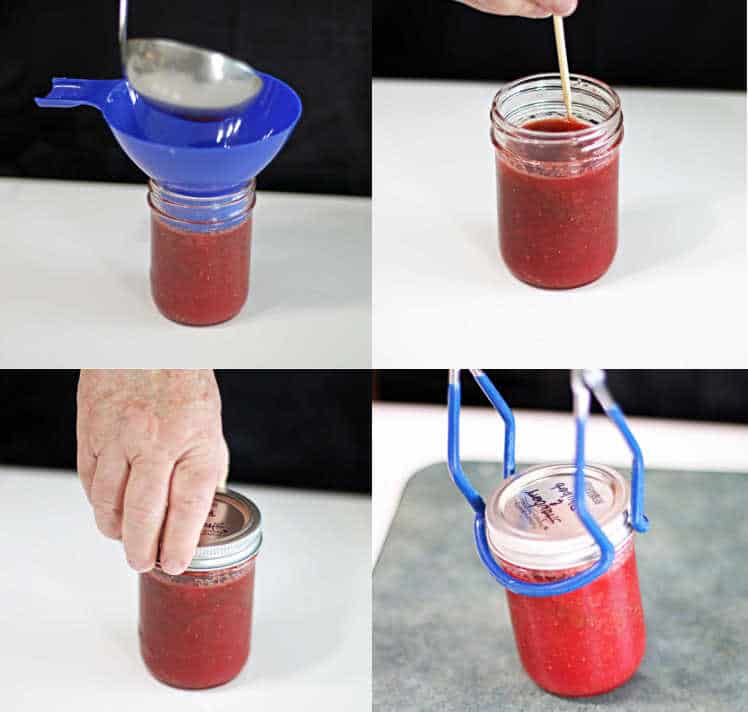
How to Test of your Canning Jars Sealed?
- As you remove the jars from the water bath, you should hear them start to pop.
- Count the pops. That pop is the sealer lid pulling down and sealing.
- Once the jars are cool, remove the screw top, press the center of the lid – there should be no flex.
- Next, try lifting the jar by holding onto the sealer lid with your fingertips. You should not be able to remove the lid.
- Finally, and this is an old trick of mine, gently tap the lids with the end of a wooden spoon and listen for the ping sound. They should all be around the same tone. If you hear a very hollow ping, that jar did not seal and needs to be refrigerated and eaten first.
*Sealer Lids: preheating Bernardin lids is no longer advised. The sealing compound used for home canning lids performs better at room temperature than it does pre-heated. Simply wash lids in warm soapy water, rinse and dry before using. (lids are not re-usable).
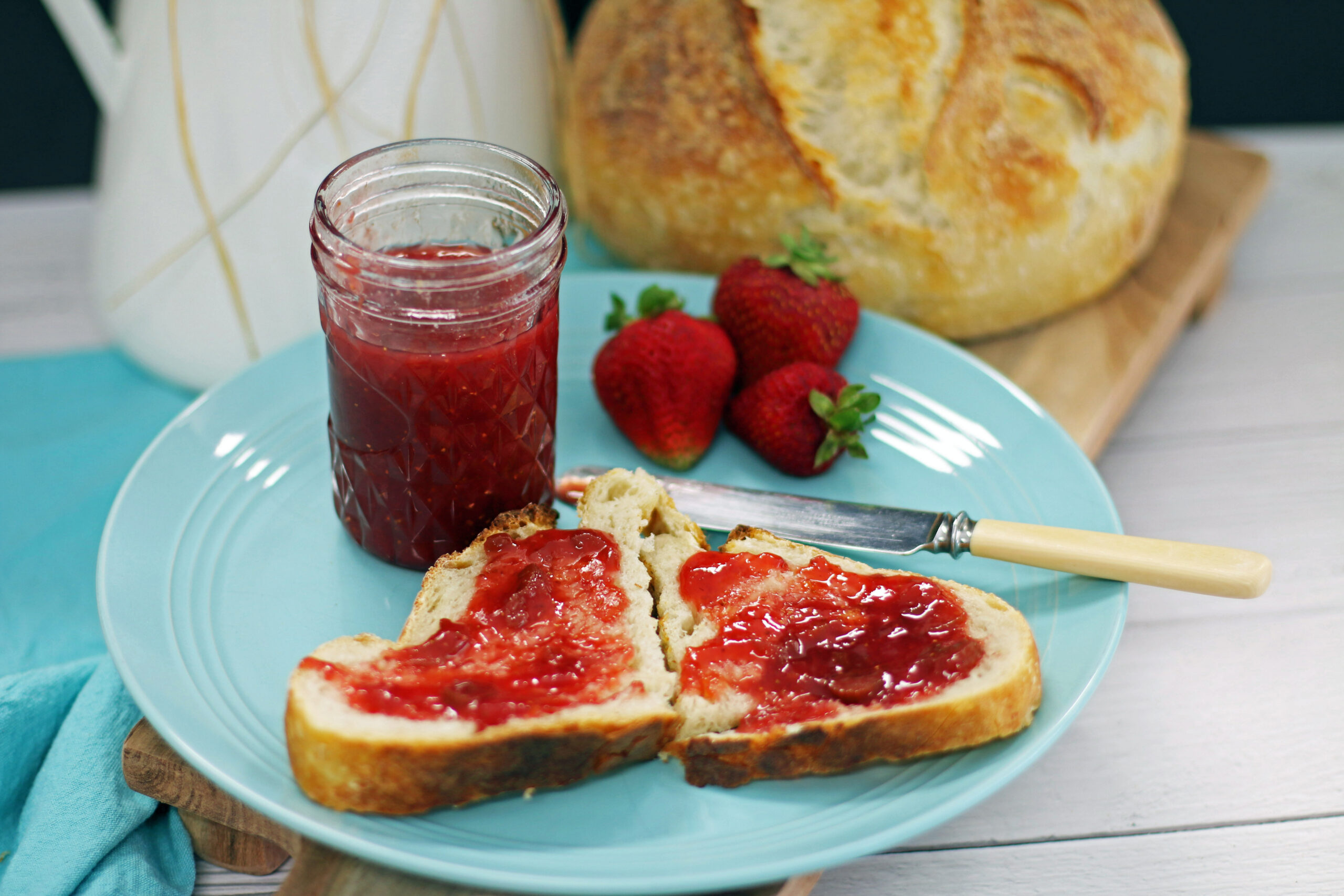
The BEST Strawberry Rhubarb Jam (with no Pectin)
Equipment
Ingredients
Ingredients
- 6 cups – sliced or crushed fresh strawberries
- 4 cups – diced rhubarb
- 6 cups – sugar
- 2 – 3 tbsp – finely grated orange rind
Optional
- 3 tbsp -bottled lemon juice (optional)
Instructions
- Combine strawberries, rhubarb and sugar in a large glass bowl. Cover with plastic wrap and store in fridge at least 12 hours, stirring occasionally. This allows the fruit to macerate and release the juices.
- When you are ready to can, fill the canning pot with water, cover and bring up to boil. While waiting for the pot to boil, wash the canning jars and lids in hot soapy water. Collect your jars, lids, screw tops and canning supply starter kit on a clean towel next to the large stock pot you will use to cook down the jam.
- Once the water in the pot has boiled, reduce heat to a simmer, add the wire rack and place your jars inside to heat up. You want your jars hot when you fill them with hot jam, this helps in the sealing process.
- Add the strawberry/rhubarb/sugar mixture to your cooking pot. I use my Hexclad 8 Qt Hybrid Stockpot with lid. It's large, has a wide base and is basically no stick for easy clean up. Add lemon juice (if you are using it). Bring to a boil over medium heat, stirring regularly.
- When the mixture begins to boil, it will start to foam. Stir it every few minutes and adjust the heat. You want it just hot enough to boil. The juices will continue to boil as the jam cooks down and thickens as some of the liquid evaporates. At the 15 minute mark, add the orange rind.
- Let it continue boiling for an additional 15 minutes until the jam reaches the thicker "jelly" stage. i.e.: if you insert a spoon and hold it up, the jam will slide off the spoon, not drip individual droplets. You could also place a small saucer in the freezer, take it out, add a spoonful of jam and tip it. If it's done, it will slide slowly across the cold plate. If it runs off quickly, cook it a bit longer.Skim off any foam sitting on top of the jam.If done, turn off the burner, but continue stirring the jam frequently.
- Fill the hot jars:Take your jars out of the hot water bath and move them to your clean towel prep space beside your hot pot of jam. Using the funnel in your canning kit, and a soup ladle, fill each jar within 1/4" of the top (leaving headspace). Use a clean damp cloth and wipe the rim of the jar to ensure it's clean (or it will not seal properly). Add the lid and the screw top, Screw the lid on until finger tight only, not crushingly tight. Add the jars back to the canner. Bring the water to a boil with the lid on, process 10 minutes (15 minutes for higher elevations).
- Use the jar tongs from your canning kit to remove the jars from the hot water bath and place them on a protected surface on your kitchen counter to fully cool. I leave mine overnight.
- At this point you can remove the screw lids if you like (I leave mine on). You want to check to make sure they sealed. Gently try lifting the lid from the jar with your fingertips, or, I just tap on the lids with a wooden spoon. If there is one that sounds much different from the others, it's not sealed. Also – when you remove the jars from the hot water bath, you will start to hear them pop, this is the sealer lid clamping down and sealing. I count the pops, and then do the tap test to ensure they are sealed.
- Let the jars cool overnight, then with a damp cloth, wipe any residue from the lids. I prefer to add the labels to the lids, as I don't like cleaning them off the side of the jars once they are empty.Alternatively, I use a black sharpie to write on the lid.
NOTES:
- It is NOT advisable to double this recipe in one pot. If you do, it doubles the cook time, making your jam much darker, and harder to gel.If you want to make more, use the same ingredients in a separate pot. I start early in the morning and do one batch after another as I usually can about 26 jars each season. Just wash out your stockpot, add some water to your canning pot, and start a new batch.Do not omit any of the sugar, or it will not set properly. The tart rhubarb offsets the sweetness of the sugar.

